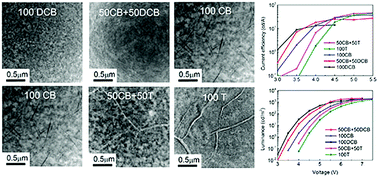A correlation between small-molecule dependent nanomorphology and device performance of organic light-emitting diodes with ternary blend emitting layers†
Abstract
The morphology of emitting layers (EMLs) plays a vital role in determining the overall performance of solution processed phosphorescent organic light emitting diodes (PhOLEDs). Herein, the morphology of undoped small molecule binary blend EMLs prepared by blending tris(4-carbazoyle-9-ylphenyl)amine (TCTA) hole transport material (HTM) with a series of electron transport materials (ETMLs) was studied using a transmission electron microscope (TEM). Experimental results show that phase separation of the binary blend EMLs significantly depends on the polarity of the host. The binary blend ELMs were further doped with tris(2-phenylpyridine)iridium(III) (Ir(ppy)3) to form ternary blend EMLs and the resulting morphology was examined using scanning transmission electron microscopy-energy dispersive X-ray spectroscopy (STEM-EDS). The results report for the first time the existence of Ir(ppy)3 needle-like aggregates in small molecule ternary blend EMLs. By comparing the size of the aggregates formed in small molecule ternary blend EMLs with those formed in polymer–small molecule blends, our results showed that small molecule blend EMLs exhibit minimal Ir(ppy)3 aggregates with a low aspect ratio in contrast to polymer–small molecule blends. The effect of mixed solvent on the distribution of the aggregates was also examined using a TEM and an atomic force microscope (AFM). The disappearance of the aggregates with varying solvent mixture ratios signifies that solvent mixture is an effective way to control homogeneous distribution of Ir(ppy)3 in the emitting layers of PhOLEDs. This was further evidenced by an improvement in light emitting efficiency and current efficiency of OLED devices fabricated using a mixed solvent.



 Please wait while we load your content...
Please wait while we load your content...